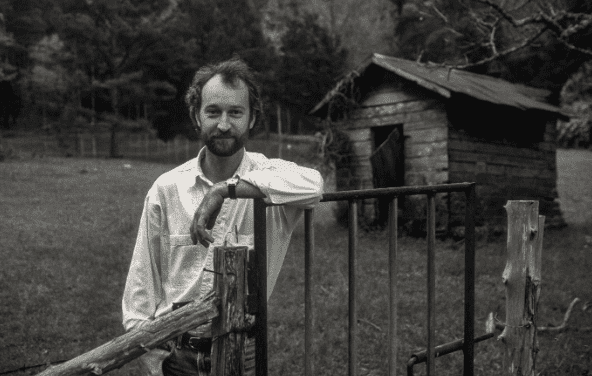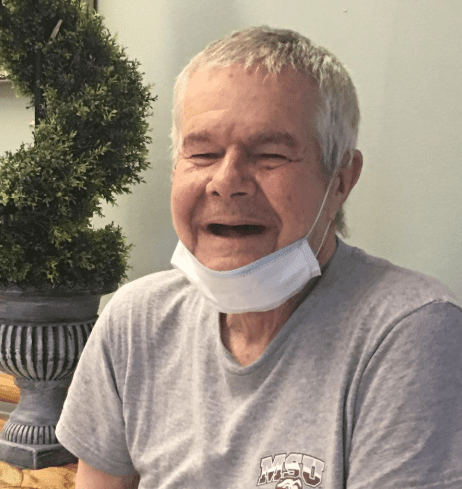
(Photo by Art Meripol)
- When Brown passed away suddenly from a heart attack in 2004 at age 53, he left the world with five novels, a memoir, a collection of essays, and three short story collections.
Between his calls as a firefighter in Oxford, Mississippi, Larry Brown ignited a fictional but undeniable South on paper and then fanned the flames, searing his name into the canon of Southern literature.
A high school graduate without formal training, Brown worked construction jobs before becoming a firefighter. Therefore, his writing background didn’t consist of literary degrees or ivy-covered halls but dangerous, taxing work, sweat, and …rejections.
The Mississippi hills where he grew up, with red clay, pine forests, and isolated hollows, were also home to a physical and emotional terrain battered by poverty and circumstance. He wrote about mechanics, waitresses, drifters, and alcoholics, everyday people rooted in real-life dramas and hardships. But his portrayals were not exploitative. He never wrote with pity but with empathy for the poetic pain in small-town lives, which he knew well, as he did the struggles of the working class. Brown’s brutal, unpredictable odyssey through twisting backroads unveiled a South far removed from the hospitable charm of “bless your heart” and porch-swing tales.
He started writing in his spare time and learned by doing, reading everything he could—William Faulkner, Ernest Hemingway, Flannery O’Connor, Harry Crews—and submitting his stories. Rejection after rejection, he kept writing. It took time for editors to notice and appreciate his stubborn, rough-edged characters and authentic stories about the rural South he knew intimately and wrote without a false note. His writing was clean, lean, and as sharp as an axe.
Ultimately, respected literary journals, such as The Southern Review, The Missouri Review, and The Oxford American, accepted Brown’s stories and repeatedly selected them for the New Stories from the South: The Year’s Best Anthology. His essays and narratives reached even wider audiences through publications like GQ and The Atlantic. Writers like Jesmyn Ward and William Gay praised him as a foundational voice who opened doors simply by refusing to write in any other way.
Brown left the fire department in 1990 to write full-time, a rare leap of faith that paid off, not in fame or fortune but in something sturdier: the respect of readers and fellow writers who saw in him a real-deal voice, someone telling stories that mattered.
When Brown passed away suddenly from a heart attack in 2004 at age 53, he left the world with five novels, a memoir, a collection of essays, and three short story collections. Among these were a short story collection, Facing the Music (1988), and his first novel, Dirty Work (1989). Joe (1991) solidified Brown as a master of Southern noir, and Father and Son (1996) is a tale of retribution and redemption.

His publisher, Algonquin Books of Chapel Hill, completed Brown’s unfinished book, A Miracle of Catfish, from his notes and published it posthumously. Possibly his most cherished and remembered character is Fay. Fay (2000) introduced a title character unlike anyone else in Southern fiction. In this novel, a naïve 16-year-old girl, Fay Jones, escapes an abusive home alone, on foot, with nothing but the clothes she wears. Fay is remarkable because of Brown’s ability to step inside a girl’s mind and render her voice with clarity and compassion. He said he wrote Fay because he couldn’t stop thinking about her after her appearance as a side character in Joe, his earlier novel. Readers were elated that Brown listened to his characters.
A realist rather than a romanticist or idealist, Brown wrote Fay’s journey without judgment, never moralizing or explaining but telling the truth about a vulnerable and cunning survivor capable of emotions and hardened by necessity, giving the reader an unflinching gaze into a bleak Southern landscape as real and raw as it gets. They understand Fay’s destructive relationships with the misguided or monstrous men she encounters because that’s all she’s ever seen and all she’s ever known.
Lafayette County, Mississippi, was home to the people who shaped Brown and from whom he shaped his characters. He was born there (Oxford) and died there (Tula). He is buried in Springdale Cemetery, a testament to his connection to the hills where he wandered as a boy and where admirers of his work continue to pay tribute to him.
Brown’s work is a living archive of Southern life in all its sorrow, strength, and strange splendor. In his work, he gave voice to characters who rarely get one, revealing meaning in the least, those too often considered insignificant, and that the South, at its messiest, ugliest, most complicated times, dares to sing their unpretentious stories.
And that’s the most Larry Brown thing: to seize the ordinary, strike a match, watch it escalate and illuminate the unflinching hardness, the intense brilliance, and the relentless beauty of the South.











